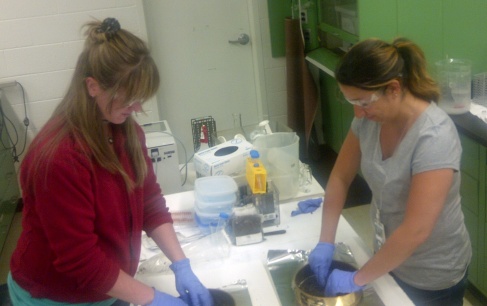I was fortunate to find a great summer ‘intern’ that joined the lab this week. Stacey Travis just finished the first year of her Masters program at University of Florida in Soil and Water Sciences. For her thesis she is working soil chemistry and phytoaccumulation of PAHs in the floodplains of the Tennessee River near Chattanooga. This summer she will be working closely with Tarah Sullivan as we make a final push to wrap up work on our DoD/SERDP project investigating the effects of soil fungi on Pb speciation that ends this year. Here they are seiving soils for our next incubation experiment (Tarah on the left and Stacey on the right)!
Month: May 2013
Big Tree of Populus Isolates
I had fun putting together a figure this weekend for a proposal. This shows a phylogenetic analysis of partial 16S rRNA genes obtained from over 2400 bacterial isolates we have collected from Populus roots in the past several years. Also I discovered in the process a cool new online tool for making this tree called the “Interactive Tree of Life” (iTOL – http://itol.embl.de/). iTOL Seems to be pretty user friendly way to display a variety of different types of data on organisms in the context of their phylogeny! Shown here is categorical information around the outside of the tree about the origin of each isolate. However this program is able to display a variety of data types and formats, including continuous information in the form of bar charts and relative abundance data in the form of pie charts.
JOB POST: Postdoc position in microbe-mineral interfaces
The Hanson and Chan laboratories at the University of Delaware are seeking motivated geomicrobiologists in training to work at the microbe-mineral interface. Our NSF funded project (award # 1244373) seeks to understand how the phototrophic bacterium Chlorobaculum tepidum both produces and consumes extracellular elemental sulfur. This is a new and rapidly developing system in microbe-mineral interactions. The project utilizes (and provides extensive training opportunities in) anaerobic microbial genetics, systems biology, electron microscopy, and nanoscale geochemical analysis methods. Our laboratories are located at the Delaware Biotechnology Institute (www.dbi.udel.edu), the newly constructed Interdisciplinary Science and Engineering Laboratory (www.udel.edu/iselab/), and we will make extensive use of advanced capabilities in UD’s BioImaging center (bioimaging.dbi.udel.edu). UD offers a number of programs for professional development and networking specifically targeted at postdoctoral researchers. We are committed to providing an environment where enthusiastic and talented postdoctoral researchers can advance their careers.
Tom Hanson (tehanson@udel.edu)
Clara Chan (cschan@udel.edu)


